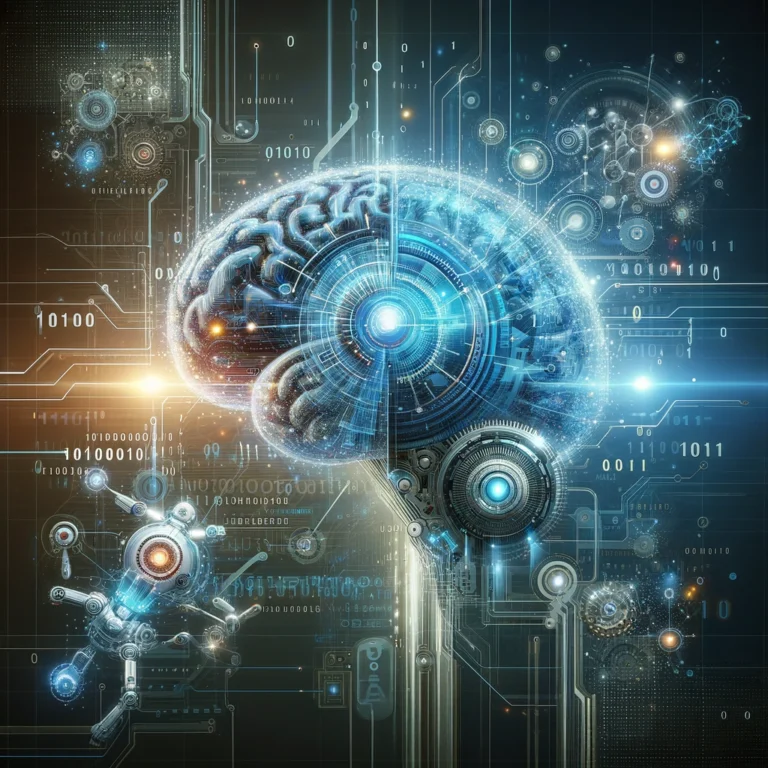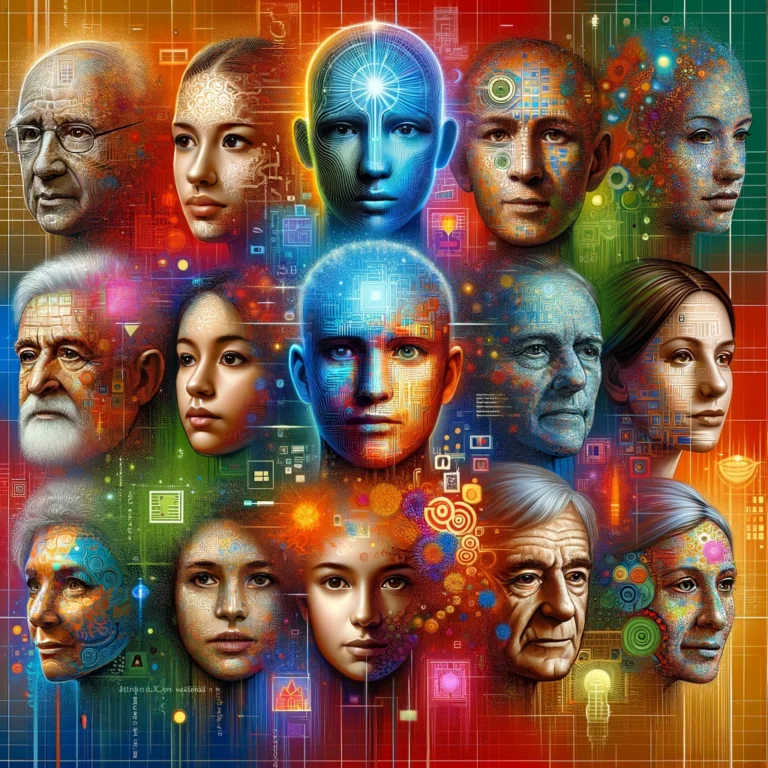Neural Networks Unveiled: Understanding the Backbone of Modern AI

Artificial Neural Networks (ANNs) stand as a cornerstone in the realm of Artificial Intelligence (AI), embodying one of the most vibrant and transformative technologies of our time.
At their core, ANNs are computing systems inspired by the biological neural networks that constitute animal brains.
This foundational inspiration has propelled ANNs to the forefront of AI research and application, enabling machines to learn and make decisions with a degree of complexity and subtlety that mimics human cognition.
1. Introduction to Artificial Neural Networks (ANNs)
Artificial Neural Networks (ANNs) are a key technology in Artificial Intelligence (AI), known for their ability to learn and make decisions like human brains.
They are computer systems made up of interconnected units called “neurons” that process information by responding to external inputs and passing responses to other neurons.
This structure allows ANNs to learn from data, making them useful for recognizing patterns, classifying information, and making predictions.
ANNs are crucial in AI because they form the basis of deep learning, a type of machine learning that uses networks with many layers of neurons.
This depth helps ANNs capture complex patterns and relationships in data, advancing fields like computer vision, natural language processing, and autonomous systems.
ANNs represent a shift towards AI systems that can learn and adapt over time, opening new possibilities for automation and interaction.
From improving medical diagnostics to powering personal assistants and advancing autonomous vehicles, ANNs are transforming theoretical possibilities into practical applications that impact everyday life.
Understanding ANNs not only provides insight into this key technology but also highlights broader questions about integrating AI into human life.
2. Historical Evolution of ANNs

The history of Artificial Neural Networks (ANNs) is marked by periods of intense research, setbacks, and breakthroughs.
Starting in the 1940s and 1950s, early models and theories were proposed by pioneers like Warren McCulloch and Walter Pitts. In 1958, Frank Rosenblatt introduced the Perceptron, an early neural network model capable of binary classification.
However, the field faced setbacks during the “AI winters” of the 1970s and late 1980s to early 1990s, when high expectations were met with technical limitations, leading to reduced funding and interest.
The introduction of the backpropagation algorithm in the 1980s revitalized the field, allowing neural networks to adjust and improve through learning.
The advent of deep learning in the 2000s, driven by advancements in computing power and large datasets, marked a turning point for ANNs.
Modern architectures like Convolutional Neural Networks (CNNs), Recurrent Neural Networks (RNNs), and Long Short-Term Memory (LSTM) networks have revolutionized various fields. Innovations like Generative Adversarial Networks (GANs) and Transformer models continue to push the boundaries of what ANNs can achieve.
The historical evolution of ANNs demonstrates the resilience and creativity of AI researchers and their impact on solving complex problems.
3. How ANNs Work
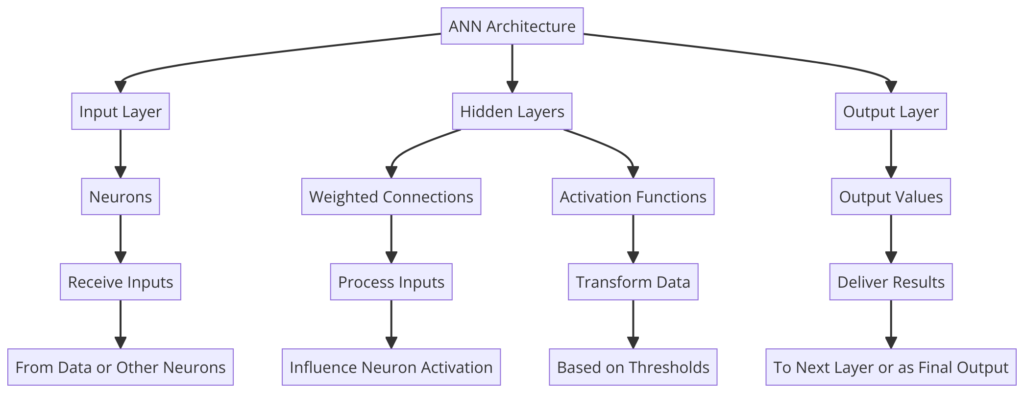
Artificial Neural Networks (ANNs) mimic the way natural neurons signal to each other, simulating neural activity through layers of interconnected neurons.
Each neuron receives input, processes it, and passes the output to other neurons.
The structure includes an input layer, hidden layers, and an output layer.
The input layer receives initial data, hidden layers perform computations, and the output layer produces the final result.
Learning in ANNs involves processing input data through the network in a process called forward propagation.
A loss function measures the accuracy of the prediction, and backpropagation adjusts the weights of the connections between neurons to minimize the loss.
Training involves learning from a dataset, and testing evaluates the network’s performance.
This intricate process enables ANNs to learn from data and make decisions, making them powerful tools for tasks like image recognition and natural language processing.
Understanding how ANNs work is fundamental to appreciating their capabilities and limitations.
4. Types of Neural Networks
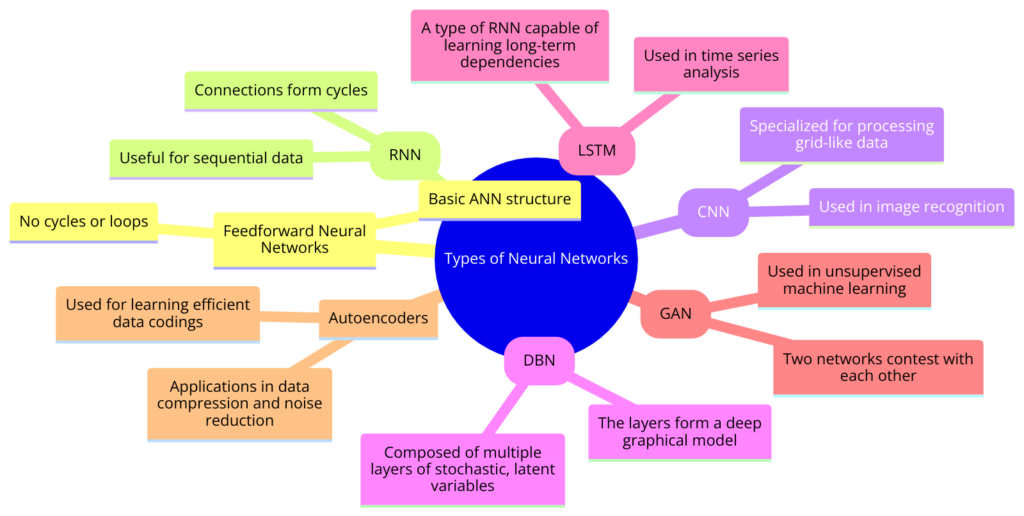
Artificial Neural Networks (ANNs) come in various architectures, each designed to address specific problems. Key types include:
- Convolutional Neural Networks (CNNs): Specialized for processing grid-like data like images, CNNs excel in image recognition and classification.
- Recurrent Neural Networks (RNNs): Designed for recognizing patterns in sequences, RNNs are used in language modeling, speech recognition, and financial forecasting.
- Long Short-Term Memory (LSTM) Networks: A type of RNN, LSTMs learn long-term dependencies, making them suitable for tasks requiring context over time, like text generation.
- Generative Adversarial Networks (GANs): Consisting of a generator and a discriminator, GANs are used for image generation and realistic environment creation.
- Autoencoders: Used for unsupervised learning and data compression, autoencoders help in anomaly detection and feature learning.
Understanding the diversity in neural network types is crucial for leveraging their capabilities across various applications, from image processing to natural language understanding.
5. ANNs in Practice
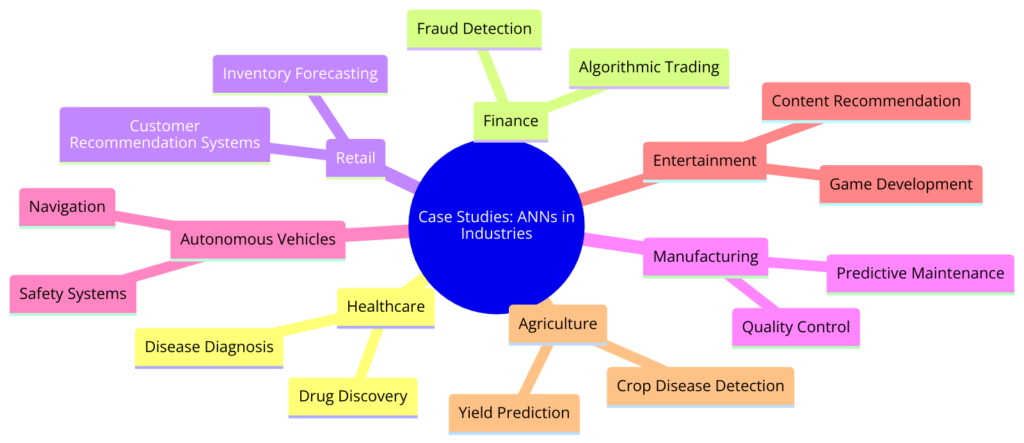
Artificial Neural Networks (ANNs) are used in various industries to drive advancements and innovations:
- Healthcare: ANNs analyze imaging data to detect diseases and predict patient responses to treatments.
- Finance: ANNs detect fraud and predict market movements for algorithmic trading.
- Autonomous Vehicles: ANNs process sensor inputs for real-time navigation and obstacle avoidance.
- Customer Service: Virtual assistants and chatbots provide 24/7 customer service.
Case studies, like IBM Watson Health’s use of ANNs for cancer treatment options and Google DeepMind’s AlphaGo, demonstrate ANNs’ impact.
However, challenges in real-world deployment include the need for large datasets, computational resources, and addressing ethical considerations like privacy and bias.
6. Challenges and Limitations
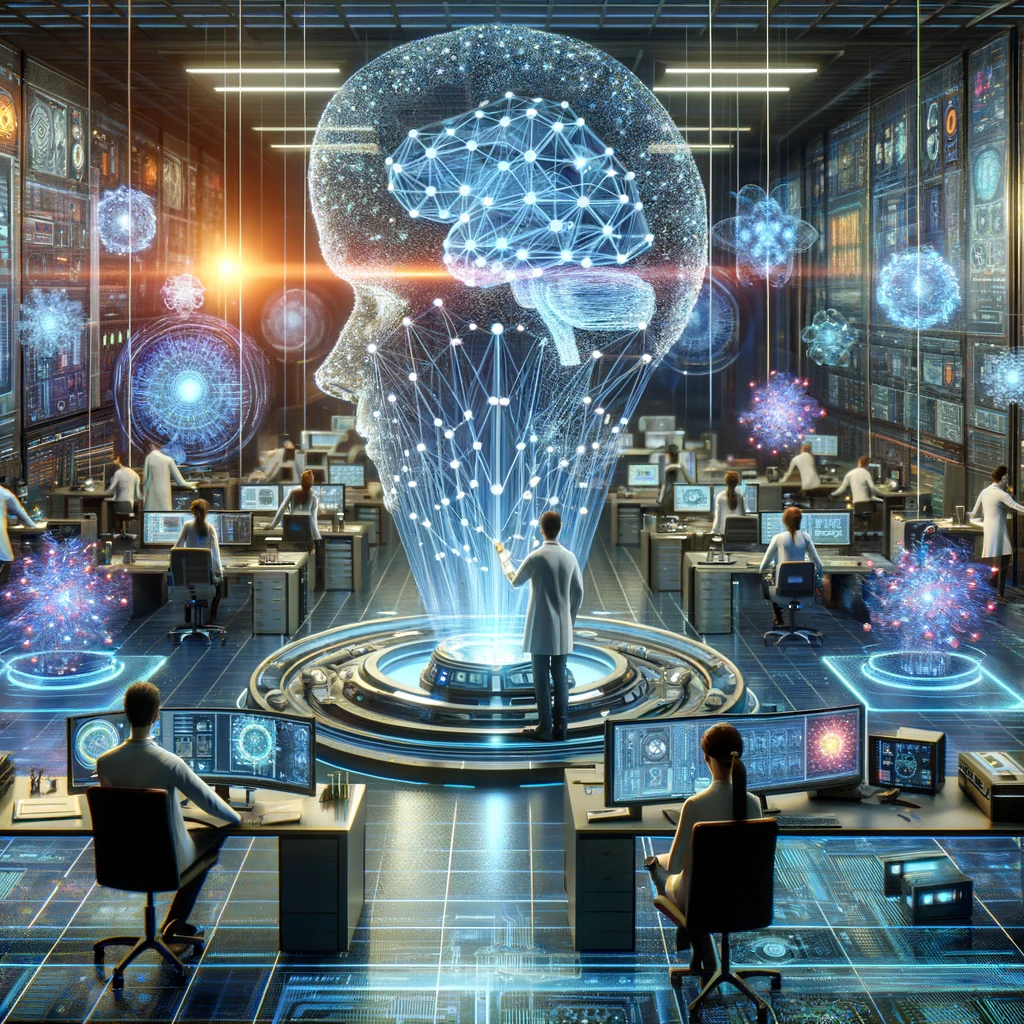
ANNs face challenges and limitations, including:
- Training Data Requirements: Large volumes of labeled data are needed, which can be resource-intensive to obtain.
- Computational Complexity: Training deep learning models demands significant computational resources and energy consumption.
- Overfitting and Generalization: Ensuring neural networks generalize to new data without overfitting is a persistent challenge.
- Algorithmic Bias: ANNs can perpetuate biases present in training data, leading to unfair outcomes.
- Transparency and Explainability: Enhancing the transparency of ANNs is crucial for accountability in high-stakes applications.
Addressing these challenges requires technical innovations, bias mitigation strategies, and ethical frameworks.
7. The Future of ANNs

The future of Artificial Neural Networks (ANNs) is marked by emerging trends and advancements:
- Efficient Architectures: Developing more efficient architectures that require less computational power and data.
- Explainable Models: Creating neural networks that are explainable and interpretable.
- Neurosymbolic AI: Combining neural networks with symbolic AI to improve data efficiency and explainability.
Future ANNs are expected to have advanced generalization abilities, support human-AI collaboration, and develop autonomous learning systems. Balancing innovation with ethical considerations is crucial for ensuring that ANNs contribute positively to society.
8. Conclusion

Artificial Neural Networks (ANNs) are a cornerstone of Artificial Intelligence (AI), driving advancements across numerous fields. From healthcare and finance to autonomous systems, ANNs transform theoretical possibilities into practical applications.
Understanding ANNs’ history, workings, types, applications, challenges, and future potential highlights their profound significance in AI.
As we continue to explore and develop ANNs, addressing challenges and ethical considerations will be crucial for responsible development.
The future of ANNs holds immense potential, promising to solve complex problems, enhance human creativity, and contribute to societal progress.
Balancing innovation with responsibility will determine the trajectory of these technologies and their impact on future generations.
Artificial Neural Networks (ANNs) – Answers to Key Questions

What are the basic concepts and definitions of ANNs?
Artificial Neural Networks (ANNs) are computational models inspired by the human brain’s network of neurons. They consist of interconnected nodes or ‘neurons,’ which process data and learn to perform specific tasks. Each neuron receives input, processes it, and passes its output to the next layer of neurons. The learning process in ANNs involves adjusting the weights of connections between neurons based on the data they process, enabling the network to make increasingly accurate predictions or decisions.
Can you provide a brief historical background of ANNs?
ANNs originated in the mid-20th century with the pioneering work of neuroscientists like Warren McCulloch and Walter Pitts, who developed the first mathematical model of a neural network. In the 1950s and 1960s, further advancements were made, including the perceptron by Frank Rosenblatt. However, it wasn’t until the 1980s and the development of the backpropagation algorithm that ANNs began to gain significant traction. The 2000s saw a resurgence in ANN research, leading to the deep learning revolution that continues today.
What are the different types of Neural Networks, and how do they differ?
Feedforward Neural Networks (FNNs): The simplest type, where data flows in one direction from input to output nodes.
Recurrent Neural Networks (RNNs): Designed for processing sequences, these networks have connections that form loops, allowing information to persist.
Convolutional Neural Networks (CNNs): Specialized for processing grid-like data (such as images), they use convolutional layers to efficiently filter and pass information.
Long Short-Term Memory Networks (LSTMs): A type of RNN adept at learning long-term dependencies, crucial for tasks requiring memory of past inputs (like language translation).
How do Feedforward Neural Networks (FNNs) function?
In FNNs, information moves in a single direction: forward from the input layer, through any hidden layers, and finally to the output layer. Each neuron in a layer receives input from the previous layer, processes it, and sends its output to the next layer. There are no cycles or loops in the network, making FNNs straightforward but powerful tools for tasks like classification.
What are Recurrent Neural Networks (RNNs), and where are they most effectively used?
RNNs are a type of neural network where connections between nodes form a directed graph along a temporal sequence. This allows them to exhibit temporal dynamic behavior and use their internal state (memory) to process sequences of inputs. RNNs are most effective in applications like language modeling, speech recognition, and any task that involves sequential data.
How do Convolutional Neural Networks (CNNs) differ from other types?
CNNs are specialized for processing data with a known grid-like structure, such as images. They differ from other networks through their use of convolutional layers, which apply a convolution operation to the input, passing the result to the next layer. This makes them highly efficient at tasks like image and video recognition, as they reduce the number of parameters needed, lessening the computational load.
What is Long Short-Term Memory Networks (LSTMs) and its significance?
LSTMs are a type of RNN capable of learning long-term dependencies in data sequences. They are significant for their ability to remember information for long periods, making them ideal for complex tasks like machine translation, text generation, and even time-series prediction where the context and sequence of the data are crucial.
What are the key components of ANNs like Neurons, Weights, and Activation Functions?
Neurons: The basic unit of computation in an ANN, receiving, processing, and transmitting information.
Weights: Parameters within neural networks that transform input data within the network’s architecture.
Activation Functions: Non-linear transformations applied to input data, determining whether a neuron should be activated or not.
How is Backpropagation used in the learning process of ANNs?
Backpropagation is a method used in training ANNs, involving a forward pass where the input is processed through the network to produce an output, and a backward pass where the error (difference between the predicted and actual output) is propagated back through the network. This process adjusts the weights of the neurons to reduce the error, gradually improving the network’s performance.
What are some common applications of ANNs in fields like image and speech recognition?
ANNs, especially CNNs and RNNs, are extensively used in image and speech recognition tasks. In image recognition, they help in identifying and classifying objects within images, vital for applications like facial recognition and medical imaging. In speech recognition, ANNs process audio data to transcribe spoken words.


